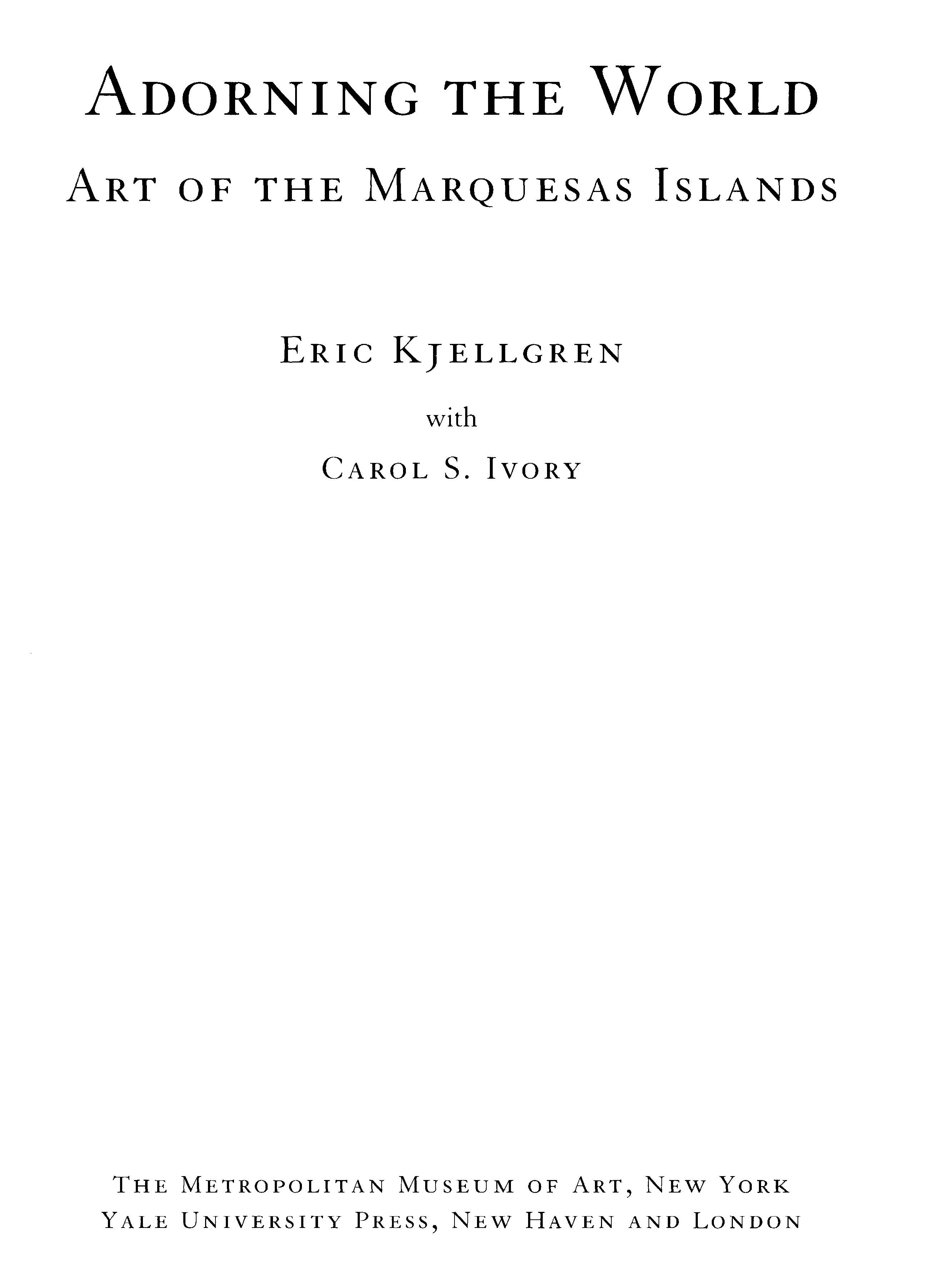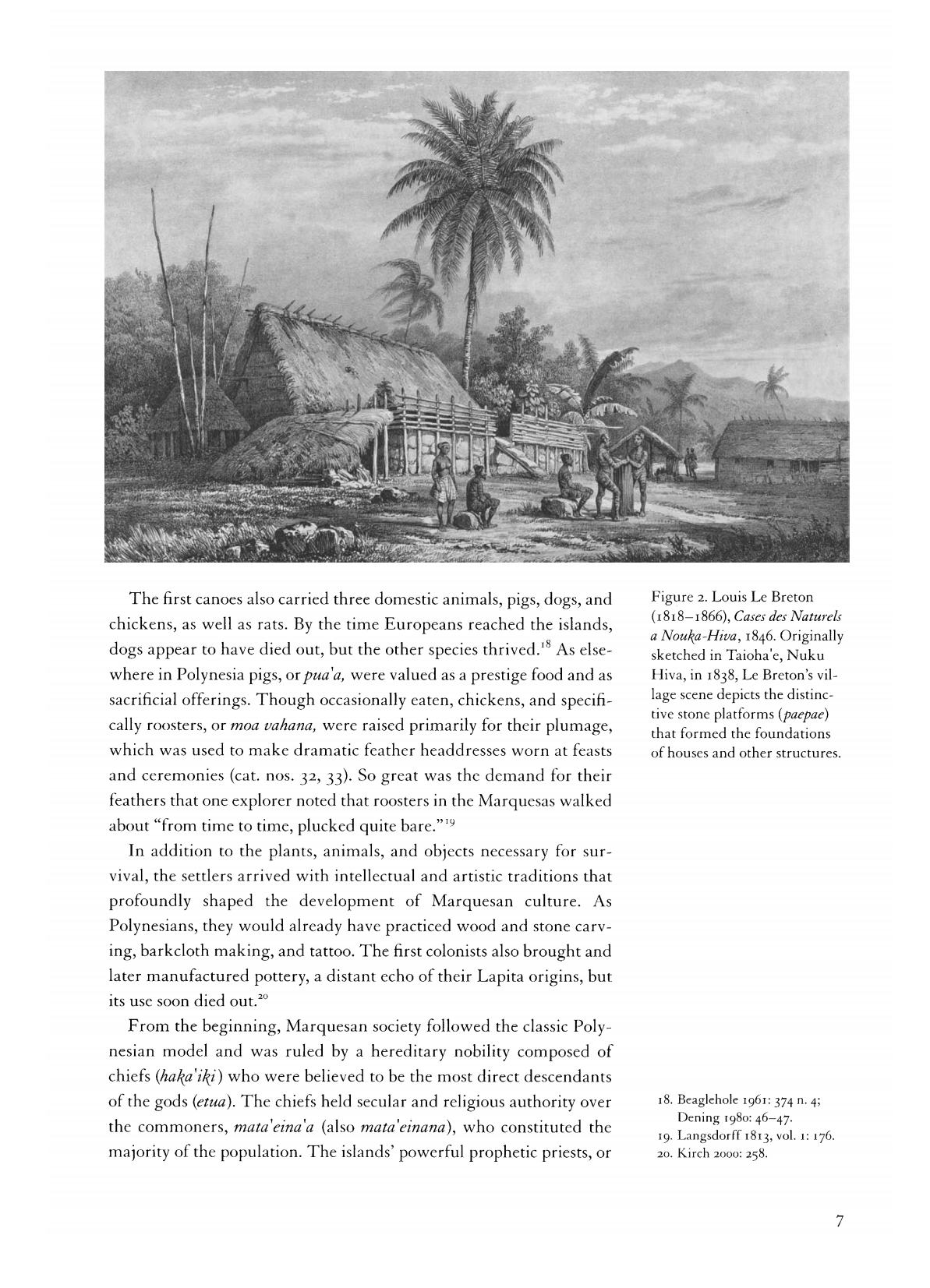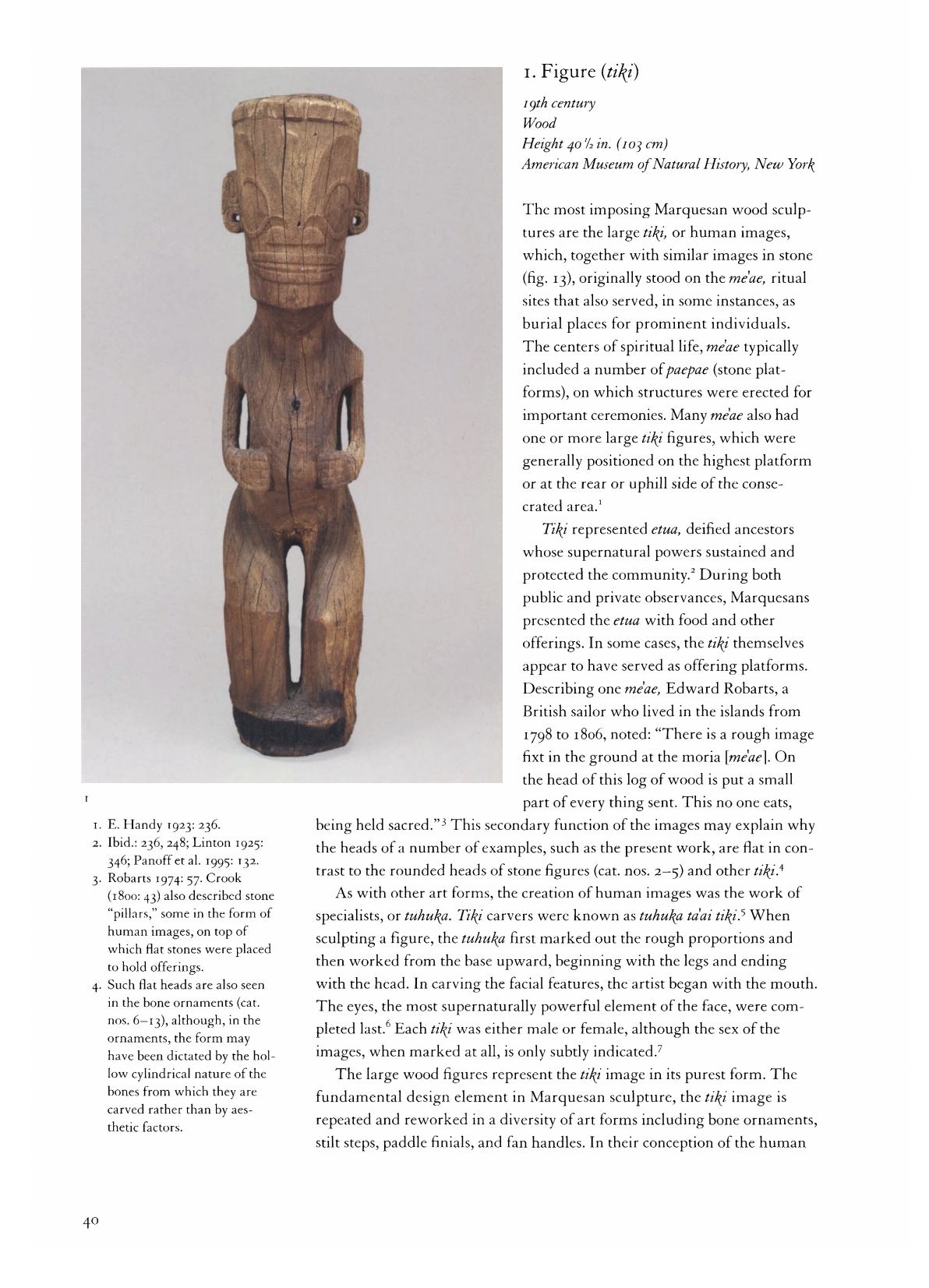|
|
Eric Kjellgren with Carol S. Ivory. Adorning the World: Art of the Marquesas Islands. — New York, 2005  Adorning the World: Art of the Marquesas Islands / Eric Kjellgren with Carol S. Ivory. — New York : The Metropolitan Museum of Art, 2005. —XII, 128 p., ill. — ISBN 1-58839-146-9 (pbk.)
Known for the elegance and complexity of their decorative art, Marquesan artists were described by Paul Gauguin as possessing "an unheard of sense of decoration" in all they created. The extraordinary ways in which Marquesans adorned their world are reflected in virtually every type of object they made and used—from sacred figures of gods and ancestors to items that were purely functional. Long admired by artists, writers, and scholars, the art and culture of the Marquesas Islands have until recently been unfamiliar to larger audiences. However, the artists of the Marquesas archipelago were among the most accomplished in the Pacific. Their work was fashioned from a diversity of materials in forms ranging from delicate ivory ornaments and luxuriant featherwork to imposing figural sculpture in wood and stone. The human body was also an important focus for artistic expression. Adorned with finely crafted ornaments, elaborate coiffures, and intricate tattoos that sometimes covered the entire body, Marquesans themselves became living art forms.
The vivid imagery of Marquesan art is testament to the myriad beings and creatures who inhabited the Marquesan universe—gods, ancestors, humans, lizards, turtles, fish—and to the islands' complex social and political organization. These art forms are explored in the present volume, published in conjunction with the exhibition "Adorning the World: Art of the Marquesas Islands," held at The Metropolitan Museum of Art.
In their catalogue essays, Eric Kjellgren, the Metropolitan's Evelyn A. J. Hall and John A. Friede Associate Curator of Oceanic Art, and Carol S. Ivory, Professor and Chair of the Department of Fine Arts at Washington State University, place the artistic traditions of the Marquesas within their cultural and historical context, giving insights into their distinctive visual imagery and their enduring influence on Western art and literature.
About the authors
Eric Kjellgren is Evelyn A. J. Hall and John A. Friede Associate Curator for Oceanic Art, Department of Arts of Africa, Oceania, and the Americas, The Metropolitan Museum of Art.
Carol Ivory is Professor and Chair of the Department of Fine Arts, Washington State University, Pullman.
Sponsors’ Statement
Air Tahiti Nui and Tahiti Tourisme are pleased to cosponsor “Adorning the World: Art of the Marquesas Islands” at The Metropolitan Museum of Art. The exhibition brings together a unique assemblage of sculpture and decorative art representing the finest achievements of Marquesan artists from the late eighteenth to the late nineteenth century.
The remote isles of French Polynesia, including the Marquesas, Bora-Bora, Moorea, Tahiti, and Taha'a, have long attracted artists, writers, and adventurers. Paul Gauguin, Herman Melville, Robert Louis Stevenson, and Jack London were all specifically inspired by their experiences in the rugged, mysterious islands of the Marquesas archipelago.
The year 2005 is an important one for Air Tahiti Nui and Tahiti Tourisme. It is our privilege to help make possible the presentation of these outstanding works from French Polynesia. In so doing, we hope to invite a broader public to experience the rich and varied cultures of our islands.
Al Keahi
Managing Director
Tahiti Tourisme
North America
Nelson Levy
Chief Operating Officer
Air Tahiti Nui
Statement from the Marquesan People
It is a great honor for me to thank, in the name of the Marquesan people, The Metropolitan Museum of Art and its director, Philippe de Montebello, for presenting “Adorning the World: Art of the Marquesas Islands.” To Eric Kjellgren, the Evelyn A. J. Hall and John A. Friede Associate Curator of Oceanic Art, who conceived and organized the exhibition, I am particularly indebted for his efforts to foster a greater appreciation of the creativity and productivity of the artists of the Marquesan archipelago. More than an exhibition will take place when “Adorning the World” opens in New York, the premier city of the United States. The exhibition will represent one of the most important moments in the hisiory of the islands themselves and will introduce a larger public to the artistic achievements of our ancestors. Marquesan artists have always been nspired by nature and have drawn on the long traditions of our culture.
It is heartening to know that the achievements of our artists, isolated as the islands art in the vast Pacific, have attracted the special attention of the Metropolitan Museum. To all those individuals who have made this exhibition possible, we offer our warmest thanks. This recognition of the treasures of our culture is a source of pride to the Marquesan people and earns our deep gratitude.
Toti Te'ikiehu'upoko
Director, Académie Marquisienne
President, Fédération Culturelle
Motu Haka des Îles Marquises
Hakahau, Ua Pou, Marquesas Islands
Director’s Foreword
It is a privilege for The Metropolitan Museum of Art to present for the first time in an art museum works from a remarkable artistic tradition that, while long admired by scholars, artists, and writers, has heretofore been unfamiliar to a wider audience. Known for their elegant stylization of the human form and the variety and sophistication of their decorative arts, the artists of the Marquesan archipelago were among the most accomplished in the Pacific. On viewing the works in the exhibition “Adorning the World: Art of the Marquesas Islands,” one is struck by the novelty and richness of Marquesan artistic expression. In this context, it is interesting to note that the imagery of these remote islands also had a direct influence on one of the most important artists in the Western canon, Paul Gauguin.
The unique visual qualities of Marquesan art that Gauguin admired more than a century ago endure. In the ornaments and functional objects they made and in the sacred images of their ancestral deities, Marquesan artists infused their work with the vitality of a centuries-old tradition. Made to honor divine beings, accentuate the beauty of the human body, and embellish both sacred and secular objects, their art encompassed and enhanced all aspects of life.
The Marquesans were renowned, in particular, for their decorative arts. Their work is fashioned in a diversity of materials and forms that range from delicate ivory ornaments to luxuriant featherwork and imposing figural sculpture in wood and stone. The human body was an important focus for Marquesan artistic expression. Adorned with finely crafted accessories, intricate tattoos, and elaborate coiffures, on festive occasions the Marquesans were themselves one of the islands’ most striking art forms. It was this distinctive visual aesthetic that captured the imagination of Western artists and explorers, whose compelling portraits also appear in the exhibition.
“Adorning the World: Art of the Marquesas Islands” presents a select group of Marquesan works drawn from the holdings of more than a dozen museums, libraries, and private collections, as well as from the Metropolitan’s own collection of Oceanic art. To the individual and institutional lenders, we are indebted for so graciously offering to part temporarily with many of their most treasured and important works, a substantial number of which are here presented to the public for the first time.
Much of the Marquesan art in the Metropolitan Museum was initially acquired by Nelson A. Rockefeller, who bequeathed his private collection of the arts of Africa, Oceania, and the Americas to the Museum in 1979. The Museum’s Marquesan holdings were later enriched by works included in an important gift of Oceanic works from Evelyn A. J. Hall.
For lending his knowledge and expertise to the organization of the exhibition and the writing of the catalogue, I extend my thanks to Eric Kjellgren, the Evelyn A. J. Hall and John A. Friede Associate Curator of Oceanic Art. I wish also to thank Carol S. Ivory, Professor and Chair, Department of Fine Arts, Washington State University, Pullman, for her contributions to the catalogue. Together, the authors place the artistic traditions of the Marquesas within their historical and cultural context and give insights into their distinctive visual imagery.
To all those individuals and organizations that have contributed to bringing this project to fruition, I express my deepest gratitude.
The Metropolitan Museum would like to thank Air Tahiti Nui and Tahiti Tourisme for their generous support of this important exhibition. We are also grateful to The Andrew W. Mellon Foundation for their valuable contribution toward the realization of this project.
Philippe de Montebello
Director
The Metropolitan Museum of Art
Contents
Sponsors' Statement.. VI
Statement from the Marquesan People
Toti Te'ikiehu'upoko.. VII
Lenders to the Exhibition.. VIII
Director's Foreword
Philippe de Montebello.. IX
Acknowledgments.. X
Map of the Marquesas Islands.. XII
Adorning the World
Eric Kjellgren.. 2
Art and Aesthetics in the Marquesas Islands
Carol S. Ivory.. 25
Catalogue
Eric Kjellgren and Carol S. Ivory.. 40
Glossary of Marquesan Terms.. 114
References Cited.. 117
Index.. 122
Photograph Credits.. 128
Sample pages 
Download link (pdf, yandexdisk; 18,9 MB).
18 января 2020, 22:39
0 комментариев
|
Партнёры
|






Комментарии
Добавить комментарий